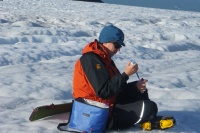Blooming bacteria identified in melting snow

Dr Arwyn Edwards, a lecturer in Biological Sciences at IBERS, collecting samples of blooming bacteria on Svalbard.
30 October 2013
Summer 2012 saw record surface melting of Greenland's ice and scientists at IBERS Aberystwyth University are using cutting-edge DNA sequencing kit to study the biodiversity of snow as it melts on a glacier in the Norwegian High-Arctic archipelago of Svalbard.
In the September issue of The ISME Journal published by Nature group, a team including Aberystwyth University scientists claims that big Greenland-wide glacier melts could lead to some of the biggest seasonal events in nature.
However, these microscopic bacteria are invisible to humans without the help of DNA sequencers.
Snow environments can occupy over a third of the land surface area in this part of the world, but little is known about the dynamics of snowpack bacteria.
Dr Arwyn Edwards a Lecturer in Biological Sciences at IBERS and the lead author of the study said: “We found snow bacteria "bloom" quickly in response to snow melt, which is of interest because 30% of the Northern hemisphere is covered with snow seasonally and large parts of it are now experiencing quick and changing patterns of snow melt because of climate instability.
The implications are for the potential of massive bacterial blooms across Greenland during snappy, but extensive melt seasons.”
While blooms by algae are well known, even in snow, a phenomenon first observed by Aristotle, they take longer to get going than permitted by widespread but brief "flashy" melting periods associated with impacts from a warming climate.
The team found that the bacterial diversity of ‘slush’ shifted very rapidly, with one group of bacteria "blooming" over the course of a week. Scientists also think that nitrogen pollution in these otherwise pristine environments help drive the "blooms".
This is important because it suggests that microbes can rapidly colonize up to 30% of land surface area in this part of the world which is covered by seasonal snow.
A sister study published earlier this year found that glacier surfaces are accumulating microbes heavily, leading to concerns that that growing microbes glue together the dust, carbon and tiny rock particles on the surface of glaciers and darken the ice surface, transferring more of the sun’s energy to the ice and melting it faster.
The scientists are now planning further studies on Greenland itself to try to catch the phenomenon in action next summer.
Gene analysis and pyrosequencing techiques revealed distinct bacterial community structures in different habitat types, with changes over 1 week apparent, in particular for the dominant bacterial class present, Betaproteobacteria.
Slush as the decompositional product of snow harboured distinct lineages of bacteria, changes in community structure after deposits on the snow surface.
Evidence for the presence of betaproteobacterial ammonia-oxidizing bacteria was uncovered, inviting the prospect that the dynamic bacterial communities associated with snowpacks may be active in supraglacial nitrogen cycling and capable of rapid responses to changes induced by snowmelt.



